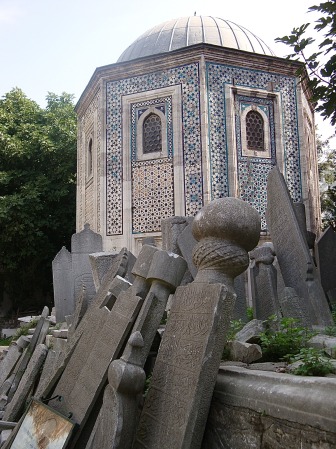“Sacred Light of Osman”
Named after the enormous mosque that is its centrepiece, Nuruosmaniye is the area immediately to the east of the Kapalı Çarşı (Grand Bazaar). The pedestrianisataion of Nuruosmaniye Caddesi that runs from the mosque to Çagaloğlu means that there is now a veritable Coffee Alley within easy walking distance of the Bazaar for those who want to refresh themselves on the way there or back again.
Around Nuruosmaniye
Although you can get here by walking from Sultanahmet many people will probably approach the area from Çemberlitaş Meydanı and its handy tram stop. From here you can walk due north towards the Nuruosmaniye Cami, passing Çemberlitaş Hamam and the Vezir Hanı on the right and, on the left, the small shops housed in the arasta attached to the mosque.
On the right you will see pedestrianised Nuruosmaniye Caddesi, a great place to come for light meals, banks and some rather upmarket shopping. Keep walking straight ahead and on the right you will see one of İstanbul’s more interesting if under-visited mosques, the Mahmud Paşa Cami, built in 1462 for one of Sultan Mehmed II’s grand viziers who is buried behind the mosque in a tomb whose lovely tiled facade immediately evokes memories of the old Silk Road. A pre-Sinan mosque designed in the Early Ottoman Bursa style, this one has a portico opening onto a narthex and then into a double-aisled interior with twin domes, a far cry from the huge spaces that later came to be a hallmark of Ottoman architecture.
But most people will be in too much of a hurry to get to the Bazaar to do anything other than turn left under the arch that leads through to the courtyard of the enormous baroque-style Nuruosmaniye Cami, built in the mid-18th century on a raised terrace and accessed via several flight of stairs and a ramp.
The first imperial mosque complex to be built after the Sultanahmet Külliyesi, the Nuruosmaniye Cami is interesting, according to urban historian Murat Gül, as the first example of a new approach to mosque architecture that utilised western-style ornamentation rather than the motifs familiar from early Ottoman buildings (the architect was the non-Muslim, Simeon Kalfa). Not only that but it boasts the only horseshoe-shaped courtyard in the city. The calligraphic text running around the interior is the complete text of the Fetih Suresi (the Victory Sura), the 48th chapter of the Koran which commemorates a treaty between Mecca and Medina in the seventh century.
The mosque grounds serve as thoroughfare leading to the most impressive of Kapalı Carşı’s many entrances, the Nuruosmaniye Kapı (Nuruosmaniye Gate) with the colourful tuğra (coat of arms) of Sultan Abdülhamid II above the heavy metal gates. Facing it a sebll or public water dispensary that was part of the Nuruosmaniye mosque complex has been converted to house a small carpet shop.
Eating and drinking
Just off Nuruosmaniye Caddesi at the Bazaar end, the stylish, flower-filled Fes Cafe is a larger branch of the tiny coffeeshop inside the Kapalı Çarşı. It’s a great place to come for a quick snack or a full-scale meal in lovely surroundings. Ali Baba Türbe Sokak No. 25, Tel: 0212-526 3070
Kahve Dünyası is a chain of coffee shops that offers much the same deal as Starbucks but for rather lower prices. It’s a great place for a quick lunch. Nuruosmaniye Caddesi No. 79, Tel: 0212-527 3282
The ice-cream chain Mado offers a wide range of sundaes as well as the super-thick ice-cream for which its hometown Kahramanmaraş is famous. Nuruosmaniye Caddesi No. 48, Tel: 0212-522 0481
Transport info
Although you can walk here from Sultanahmet the nearest tram stop is at Çemberlitaş.
Nearby areas


